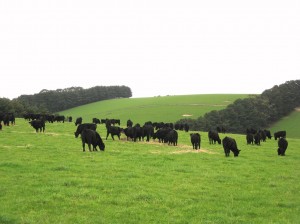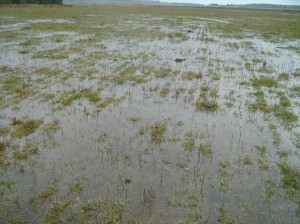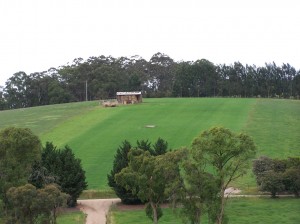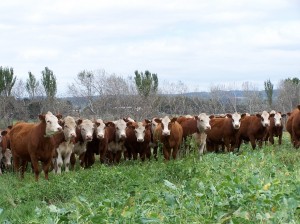Fill the winter feed gap
The issue

The main factors that influence the growth of pastures are sunlight, moisture, nutrients and temperature. Over the winter period, it is generally temperature that impacts most on pasture growth, causing a growth rates to drop to very low levels (0 – 15 kgDM/ha/day). These low pasture growth rates often result in insufficient feed to meet the demand of the stock on hand. This is known as the winter feed gap. Typical winter pasture growth rates can be found under Regional pasture growth rates.
Strategies to fill the winter feed gap prevent overgrazing, which improves future growth rates, reduces bare ground and weed invasion, and importantly, maintains stock health.
What are the options?
- Build a feed wedge, or surplus feed, leading into winter,
- Improve winter growth rates of existing pastures,
- Use supplementary feed,
- Introduce other pasture species into the farming system.
Build a feed wedge leading into winter
Improving the autumn growth rates of the pasture can allow the supply of pasture to exceed the demand of stock during this time, allowing a feed wedge to be grown in front of the stock. This wedge is then eaten into during the slower growing winter months in readiness for the spring flush.

To grow a feed wedge for winter, supplementary feeding during the autumn is generally required. The advantage of feeding during autumn is the return you get from the pasture growth rates compared to what you get if you feed in winter. Slowing the rotation by supplementary feeding results in a longer rest period for the paddocks and time for the additional feed to grow.
An alternative to supplementing stock to grow the feed wedge, is to apply nitrogen across a number of paddocks to increase the growth rates of the pasture. The most cost effective way of applying nitrogen is as urea, which has approximately 50% available nitrogen. The faster the grass is growing naturally, the more cost effective the use of urea will be. Consequently, using urea in the autumn period to grow a feed wedge is generally more effective than applying urea in the winter months to boost growth during that period. Responses to nitrogen will vary with pasture species (e.g. annual grasses>Perennial grasses) and if other nutrients (eg phosphorus and potassium) are not limiting.
An advantage to using nitrogen to boost pasture production is that it has been shown to increase tiller density with good grazing management (as utilising the additional feed grown). High tiller numbers are essential for long term survival or perenniality of pastures.
Improve the winter growth rate of existing pastures
Nitrogen

Nitrogen is commonly used to increase pasture growth rates in winter. Urea is the best option as it is less prone to losses (leaching and de-nitrification) during cold wet months than other sources of nitrogen. Urea is best applied immediately after stock have been removed from the paddock. It has been shown that delaying the application of nitrogen fertiliser reduces the potential pasture response by about 1% per day after stock have been removed.
Soil temperature, soil moisture, soil fertility and species composition all impact on the pasture responses to applied nitrogen. A north facing slope may be as much as 2°C warmer than a south facing slope in winter. Applying nitrogen to the north facing slopes in July and south facing slopes in August as temperature begin to warm can give a greater growth response than applying nitrogen to both areas at the same time.
If pasture is moisture stressed (either too dry or too wet), the response to nitrogen is restricted. Annual grasses respond most efficiently to nitrogen fertiliser, followed by short rotation grasses, then perennial grasses. If other nutrients (e.g. phosphorus, potassium) are limiting growth the response to nitrogen could also be reduced. Data from a cutting trial at Ellinbank indicated that responses to nitrogen are limited at soil phosphorus levels below 14 mg/kg Olsen P.
The EverGraze N Fertiliser, Gibberellic Acid and Supplementary Feed Tool can be used to determine the most cost effective way to boost pasture growth.
Gibberellic acid
Gibberellic acid is a naturally occurring plant hormone that stimulates growth through cell expansion. In grasses, this results in stem and leaf elongation. Gibberellic acid is produced in higher quantities in warmer months, and at low levels during colder months. Applying gibberellic acid in colder winter months stimulates the plant and can improve the quantity of feed on offer (FOO). The rapid growth is often lighter (yellow) in colour for the first couple of weeks after application. The quality of the feed on offer is not affected.
Results can be obtained using rates of 5 to 20g of gibberellic acid/100L water. It is recommended that it is applied in a minimum volume of 100L/ha. Phalaris is highly responsive to gibberellic acid and rates of 5 to 10g/100L are appropriate.. If applying to perennial ryegrass pastures, annual ryegrass or cocksfoot, 10-20g/100L is required. Multiple applications can be used on a paddock in conjunction with a rotational grazing program. Growth stimulation is usually seen within seven days of application and ceases around 3-4 weeks after application. The final application of gibberellic acid should be no later than mid- August. At this time the soil temperatures are rising, natural levels of Gibberellic Acid become sufficient in the plant and there is no effect of treatment.
Applications in late winter (post mid-August) or early spring may in fact lead to a suppression of spring growth. Soil nutrient levels also need to be adequate to support the additional growth that applications of gibberellic acid may induce.
The EverGraze N Fertiliser, Gibberellic Acid and Supplementary Feed Tool can be used to make your own estimations of likely responses and cost effectiveness to applying Nitrogen and/or gibberellic acid. The calculator incorporates the cost of application, the quality (digestibility) of the feed, expected responses to applications and utilisation of feed to calculate cost on a cents per megajoule (c/MJ) comparison. The Tool can also be used to compare the costs of supplementary feeding with Nitrogen or Gibberellic Acid application.
Use supplementary feed
Supplementary feeding should aim to fill the requirements of stock that the pasture cannot provide. An appropriate supplementary feed needs to make up for the main deficiency in the paddock feed. In winter, short green feed has a high energy value, but there is inadequate quantity – therefore energy intake is limiting. Protein is usually far higher than that required by livestock. The idea of a good supplement is to maintain good rumen function and animal health, so the energy, protein, fibre and mineral requirements of the stock must be taken into account.
The supplement chosen will depend on the class of the animal being fed and the requirements of those stock. It is important to feed animals with the greatest needs first. Consider whether the animal is young and growing, pregnant, lactating, dry, and what condition they are in. Generally, dry stock will be lowest ranking, but they may still need feeding if their body condition is inadequate.
Common feeds used for supplementary feeding include hay, silage, grain or grain based stock pelletsthat are available in a range of different energy and protein content.
The EverGraze Feedbase Planning and Budgeting Tools contains a useful option ‘Develop a Livestock Feed Ration’ that can help you identify the most cost effective supplementary feed.
Introduce more winter active plant species.

A longer term option to fill the winter feed gap may be to introduce more winter active species into some paddocks.
Climate, soil type, land class and livestock enterprise will affect your available options. You will also need to consider whether incorporating more winter active species will reduce annual pasture production for example annual rye grass, and if so consider how much of the farm should be resown. Species to consider include forage cereals, winter active lucerne, annual grasses, short term grasses, perennial grasses with good winter production, brassicas, or a mix of a crop with grass.
You could look at using PasturePicker or talk to your local seed provider to get the best species/varieties for your farm (as new varieties are often released), but you could consider:
- Winter active tall fescues such as Prosper, Fraydo, Resolute, Flecha or Origin
- Phalaris varieties noted for winter activity such as Advanced GT, Landmaster, Holdfast GT, Lawson or Sirolan
- Cocksfoot varieties with good winter activity such as Kasbah and Yarck
- Annual ryegrasses, particularly produce good quantities of feed over winter, followed by short term ryegrass, then perennial ryegrasses
- Winter active Brome grasses such as Exceltas, Bareno, Atom and Matua
- Lucerne varieties particularly noted for good winter grazing include; Pegasis, Sardi Ten, Force 10, WL925 and ML99
- Forage cereals; oats (sow Feb-May), triticale (sow Mar-June) or Barley (sow April-Aug)
- Brassicas can be sown alone for additional winter feed or in conjunction with an annual ryegrass. Rape (sow in autumn for winter feed), turnips (slower growing varieties will provide autumn/winter feed), swedes (sow Nov-Jan) can provide handy autumn to winter feed, kale (sow Oct-Jan) to provide summer/autumn and early winter feed

